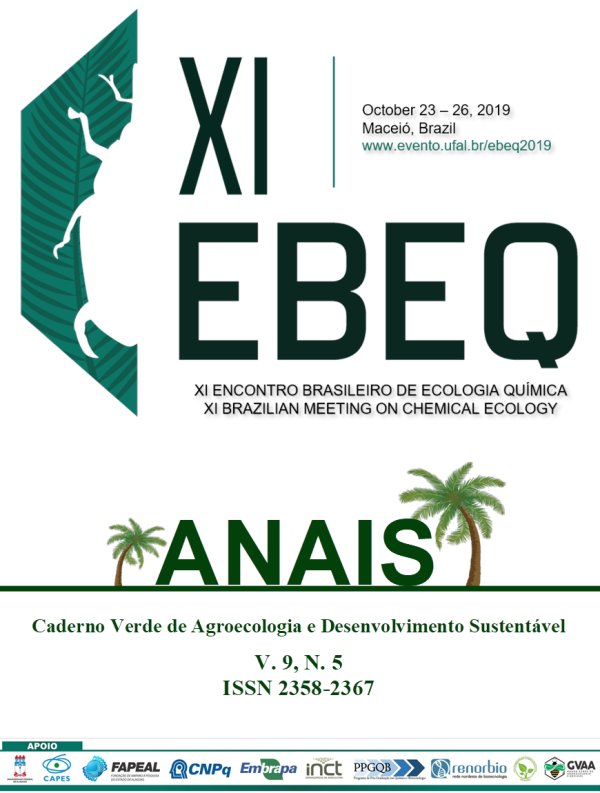NEUROPEPTIDE SYNTHESIS IN ANTENNAE: GENE EXPRESSION PROFILES EMERGING FROM INSECT PHYLOGENY
Resumen
Our results have recently confirmed the expression of neuropeptide genes (NPGs) in the antennae of the triatomine bugs Rhodnius prolixus and Triatoma infestans. Besides, expression of a broad set of GPCR-coding genes associated to neuropeptide (NP) signaling processes has also been reported. Our data had also evinced that antennae produce transcripts for enzymes responsible for the post-transductional processing of prepropeptides. Furthermore, we presented evidence of enzyme gene expression related to synthetic pathways for biogenic amines (as well as expression of genes coding for their receptors). The present study compares diverse antennal transcriptomes (from Aedes aegypti, Anopheles gambiae, Anopheles quadriannulatus, Apis mellifera, Drosophila melanogaster, Rhodnius prolixus and Tribolium castaneum) belonging to four insect orders to validate whether NPGs are expressed in antennae. Transcriptome profile comparison has clearly shown that diverse NPGs present consistent antennal expression in seven species (including both holometabolous as well as hemimetabolous insects). The very high levels of expression observed for IDLSRF (known as Prohormone-4 precursor), ITG and ITP genes in the antennae of all species suggest functional roles related to the control of sensory function for these NPs for which there is yet limited evidence for other physiological roles. Additionally, DH31, OK, RYa, SIFa, sNPF and TK were expressed consistently in the antennae of most species studied. Besides, NPGs coding for AKH1, allatostatins (AstC, AstCC, MIP), allatotropin, CAP-2b, CNMa, diverse ILPs, LNPF, Lst, MS, NPLP1, NVP-like, PBAN/PK, PDF and SK presented expression in the antennae of several species. A subset of GPCR-coding genes had consistent expression in antennae of most species. Interestingly, several genes coding for nuclear receptors, which probably represent an alternative signaling system modulating antennal sensory processes due to their responsiveness to insect hormones, had consistent antennal expression. The set of genes coding for enzymes necessary for prepropeptide processing, as well as those participating in biogenic amine synthesis, had consistent antennal expression. The latter suggests that insect antennae present the biochemical machinery needed for local synthesis of these signalling molecules. The potential antennal role of this modulatory machinery will be discussed in the context of insect sensory processes.Descargas
Publicado
Cómo citar
Número
Sección
Licencia
Termo de cessão de direitos autorias
Esta é uma revista de acesso livre, em que, utiliza o termo de cessão seguindo a lei nº 9.610/1998, que altera, atualiza e consolida a legislação sobre direitos autorais no Brasil.
O(s) autor(es) doravante designado(s) CEDENTE, por meio desta, publica a OBRA no Caderno Verde de Agroecologia e Desenvolvimento Sustentável, representada pelo Grupo Verde de Agroecologia e Abelhas (GVAA), estabelecida na Rua Vicente Alves da Silva, 101, Bairro Petrópolis, Cidade de Pombal, Paraíba, Brasil. Caixa Postal 54 CEP 58840-000 doravante designada CESSIONÁRIA, nas condições descritas a seguir:
O CEDENTE declara que é (são) autor(es) e titular(es) da propriedade dos direitos autorais da OBRA submetida.
O CEDENTE declara que a OBRA não infringe direitos autorais e/ou outros direitos de propriedade de terceiros, que a divulgação de imagens (caso as mesmas existam) foi autorizada e que assume integral responsabilidade moral e/ou patrimonial, pelo seu conteúdo, perante terceiros.
O CEDENTE mantêm os direitos autorais e concedem à revista o direito de divulgação da OBRA, com o trabalho simultaneamente licenciado sob a Licença Creative Commons do tipo atribuição CC-BY.
O CEDENTE têm autorização para distribuição não-exclusiva da versão do trabalho publicada nesta revista.
O CEDENTE têm permissão e são estimulados a publicar e distribuir seu trabalho online (ex.: em repositórios institucionais ou na sua página pessoal) a qualquer ponto antes ou durante o processo editorial, já que isso pode gerar alterações produtivas, bem como aumentar o impacto e a citação do trabalho publicado.








